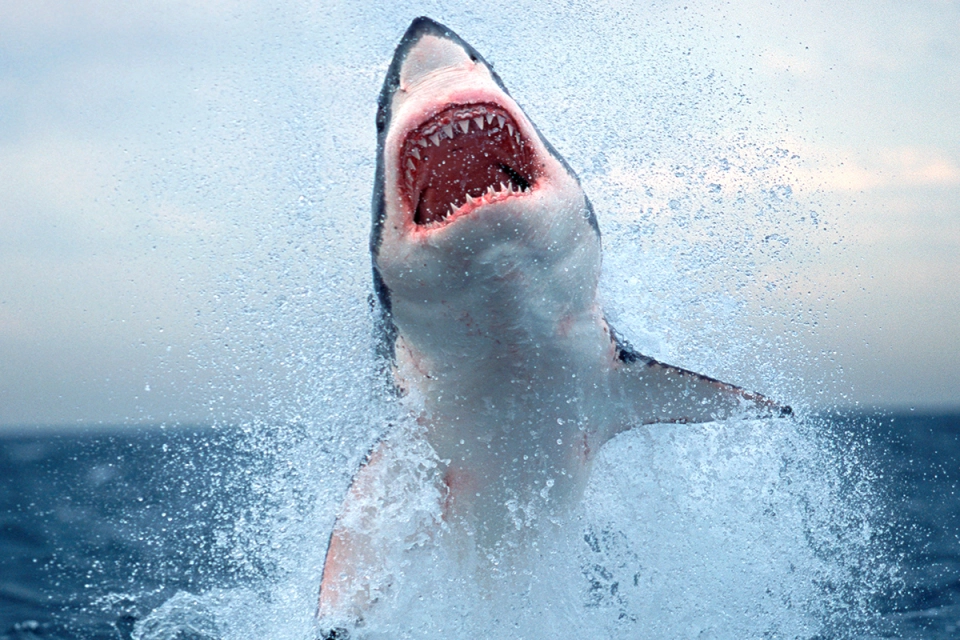VIDEO EXCLUSIVE: Dr. Austin Gallagher On Coming Face To Face With Giant Great White Shark For ‘Shark Week’
Dr. Austin Gallagher, biologist and host of Discovery’s Shark Week special, Belly of the Best: Feeding Frenzy, discussed his experience with coming face to face with a great white shark for the special in an exclusive uInterview.
Gallagher’s program was chosen to kick off the 2023 Shark Week television schedule. The special sent Gallagher down into a whale decoy while his team gathered data about the behavior of great white sharks in South Africa.
Gallagher explained the danger that great white sharks in South Africa are currently facing.
“South Africa has been ground zero for Shark Week for almost three decades now. That is because it’s a white shark hotspot, and we have been very fortunate to study and film there for so long,” said Gallagher, who has been featured on Shark Week many times. “The situation has changed in the last two years. Two orcas — killer whales — have moved in and started hunting white sharks, they have been washing up on beaches which is how we know it’s happening. It scared the remaining white sharks away.”
“The big sharks have largely disappeared,” Gallagher continued. “So we need to find those sharks to monitor the population and enact effective conservation.”
Gallagher was sent to find the great white sharks while in a model of an orca whale, an idea that he originally came up with about three years ago. He discussed the process of constructing the decoy.
“We had to construct something that was realistic. We had to build it in South Africa and we obviously wanted to put a diver scientist — myself — inside of it, so it had to be safe. It was quite the journey, but this crazy idea actually worked incredibly well.”
To attract the sharks, the fake whale created a “chum storm,” by spewing fish meat and blood into the water. The great white sharks then gathered around the whale, allowing Gallagher to examine them up close. One shark took a particular interest in the decoy.
“One of these 10-foot white sharks came up to me and just stared me right in the face and he just couldn’t figure me out,” he recalled. “They are sentients, they do have incredibly advanced capabilities for learning and so they were trying to figure me out. It was a really cool moment looking at that shark, I felt like it stopped in its tracks.”
Though a lot of time and research went into building the decoy whale, Gallagher’s safety was not guaranteed. When asked how he knew that he would make it out of the water, he said that the team did not know anything for sure.
“We did go through a lot of testing,” Gallagher explained. “But when the big shark at the end would even just bump into [the decoy], the whole thing moved… That was pretty scary for sure, I had an exit strategy for when the big shark showed up… When the big shark is at the surface that’s when it’s calm, but when it’s at the subsurface it’s making all of its calculations… I was more worried when I couldn’t see the shark but knew it was in the area. I was ready to swim as fast as I could to the boat.”
Gallagher was able to tag one of the larger sharks, which marked a huge moment in shark science. Other divers have since been able to see the shark in South Africa, and researchers have been tracking its movement.
“We knew we wanted to tag them because these large, illusive great whites are the ones that are missing from our population study off of South Africa. This speaks to the really important work done by my colleague, Dr. Allison Towner, who is in the show. It’s great to put a tag on an animal like that to see where they are moving to, it may give us clues to where the population has been displaced to. These animals are incredibly important and we need to protect them.”
Gallagher offered his advice to civilians on what they should do if they were to ever encounter a shark.
“Stay calm. Try and get in the boat if you can, but don’t make any sudden movements. Sometimes it’s best to just stand your ground, which sounds crazy. Making eye contact with the big, predatory sharks is usually what you need to do in order to assert your dominance,” Gallagher said. “If you start swimming away, sometimes you look like a prey item… You usually don’t want to be in the water when sharks are diving, you don’t want to go swimming near seal colonies.”
When asked to reflect on his experiences in Belly of the Beast, Gallagher nodded towards technology as the force that made the show possible.
“Innovative technologies are always really effective, and that’s how we pushed the boundary this year,” he said. “New platforms allow us to get closer to sharks than ever before and really focus on the behavior. One of the things you’re going to see on Shark Week in its 35th year is that behavior is the most exciting thing. Whether we are talking about breaches or whale carcasses, it’s a celebration of sharks like never before.”
RELATED ARTICLES
Get the most-revealing celebrity conversations with the uInterview podcast!









Leave a comment